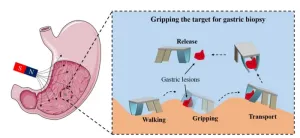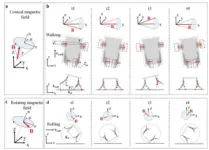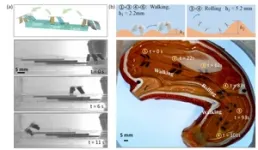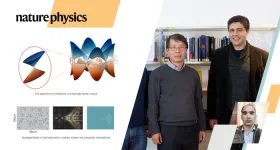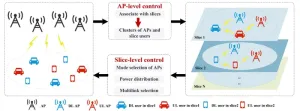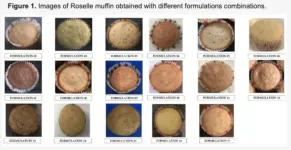Recently, a research team from Shenzhen Institute of Advanced Technology, Chinese Academy of Sciences, proposed a bionic quadruped soft thin-film microrobot actuated by magnetic fields with a mass of only 41 mg, which promises to be applied to stomach examination and treatment. Researchers realized the multimodal locomotion control of the soft microrobot in magnetic fields and the grasping and transportation of micro-objects by the soft microrobot.
The new paper, published in Cyborg and Bionic System, details the process of making the microrobot and the magnetization process, presents the mechanism of microrobot's locomotion and cargo transportation, and demonstrates the microrobot transporting multiple microbeads from different locations to the target position.
Untethered microrobots have received much attention for their potential in biomedical applications and small-scale micromanipulation. “Due to the fact that magnetic fields are harmless to biological cells and tissues, magnetic fields are widely used to actuate microrobots for biomedical applications,” explained study author Tiantian Xu , a professor at the Shenzhen Institute of Advanced Technology, Chinese Academy of Sciences.
Inspired by intelligent creatures in nature, researchers designed and fabricated a new untethered quadruped soft thin-film microrobot consisting of 4 magnetic soft legs with special magnetized profiles and a nonmagnetic film body. The robot with simple structure was fabricated by demolding technology, and the molds were produced by high-precision 3-demensional(3D) printing process.
According to the researchers, by using different actuating magnetic fields, the microrobot was able to achieve multimodal locomotion, including straight travel and scrolling. By generating a conical magnetic field, the microrobot can alternately move its legs to achieve walking on a flat surface, just like the gait of a quadruped.
The quadruped microrobot not only has stable multiple movement modes and flexible steering control but also can move in a variety of complex obstacle environments. The microrobot can walk across 3 levels of steps, each with a height of 1mm. In addition, the quadruped microrobot can move on the bottom of the stomach model filled with grooves. The robot can walk over some low obstacles that are approximately 2.2mm high. When the height of the obstacle is larger, the advantage that the microrobot has multimodal locomotion will show up. In this case, the microrobot can switch to rolling mode to cross the obstacle.
The quadruped microrobot not only has excellent obstacle-crossing capability but also has excellent cargo gripping capability. The magnitude of the magnetic field component in the lateral direction of the microrobot body enables the adjustment of the distance between the rear legs of the microrobot, which enables the gripping and releasing of cargo. Researchers have succeed in controlling the microrobot transporting 2 target beads in different positions to the specified target location, which actually verifies the ability to grip and transport the cargo. As for the load capacity, experimental results show that the microrobot can grasp and transport objects up to 3 times its own weight.
Different from the existing wired soft robots that have been used in the medical field, the quadruped soft microrobot proposed by the Shenzhen Institute of Advanced Technology has better moving capability, obstacle-crossing capability and target transportation capability due to the advantage of multimodal locomotion.
Looking forward, Prof. Xu said that the quadruped soft microrobot is expected to be applied to stomach examination and treatment. And they will continue to devote to optimizing the microrobot design toward mor efficient motion and better gripping capabilities.
This work was supported in part by National Key Research and Development Project under Grant SQ2020YFB130100, in part by the National Natural Science Foundation of China under Grants 62022087 and U22A2064, in part by the Shenzhen Science and Technology Innovation Commission under Shenzhen Fundamental Research Program under Grant JCYJ20220818101611025, in part by the Youth Innovation Promotion Association of CAS, in part by the Special Support Project for Outstanding Young Scholars of Guangdong Province under Grant 2019TQ05X933, in part by the CAS-Croucher Funding Scheme for Joint Laboratories under Grant 172644KYSB20200044 and the Croucher Foundation Grant with reference no. CAS20403, in part by the Shenzhen Institute of Artifcial Intelligence and Robotics for Society, in part by DMETKF2022008, and in part by SIAT-CUHK Joint Laboratory of Robotics and Intelligent Systems.
The paper, "Multimodal Locomotion and Cargo Transportation of Magnetically Actuated Quadruped Soft Microrobots," was published in the journal Cyborg and Bionic Systems at DOI: https://doi.org/10.34133/cbsystems.0004
Reference
Authors:Chenyang Huang1,2,3, Zhengyu Lai1,2,3, Xinyu Wu1,2, and Tiantian Xu1,2*
Title of original paper: Biohybrid Micro- and Nanorobots for Intelligent Drug Delivery
Journal: Cyborg and Bionic Systems
DOI: 10.34133/cbsystems.0004
Affiliations:
1 Guangdong Provincial Key Lab of Robotics and Intelligent System, Shenzhen Institute of Advanced Technology, Chinese Academy of Sciences, Shenzhen 518055, China.
2 SIAT Branch, Shenzhen Institute of Artifcial Intelligence and Robotics for Society, Shenzhen 518055, China.
3 University of Chinese Academy of Sciences, Beijing 100049, China
A brief introduction about yourself.
About Dr. Tiantian Xu:
Tiantian Xu is currently a Professor with the Shenzhen Institute of Advanced Technology, Chinese Academy of Sciences, Shenzhen, China. Her research focuses on design and control of magnetically actuated microrobots. She build a Magnetically Steerable Guidewire Micro-robotic System R&D team and provide research leadership to design, develop and produce Micro-robotic System for minimally invasive surgery. She has published more than 40 SCI papers in the recent five years in Science Robotics,Adv Mater, IEEE Transactions on Robotics, IEEE/ASME Transactions on Mechatronics, IEEE Transactions on Cybernetics and other journals with the h-index of 21 and total citations of over 2300. She served as the associate editor for IEEE international journals and conferences in robotics and automation such as IEEE TRO, IEEE TASE, IEEE RAL, ICRA, and IROS.
Personal Homepage: https://people.ucas.edu.cn/~xutiantian?language=en
END
